@TDAM_Canada
Investor Knowledge + 5 Minutes = New Thinking
Typically, the economy tends to be very cyclical, following patterns we have seen in the past, time and time again. We usually experience four stages: expansion, peak, contraction (also known as recession), and trough and eventually another expansion to mark the beginning of a new cycle. These cycles can range from as short 2 years or less to more than a decade, but usually last on average just over 5 years. Lately, the term 'super-cycle" has been popping up in headlines and conversations about our current environment within commodities. So, what exactly is a super-cycle?
A commodities super-cycle can be described as a period of consistent and sustained price increases, usually driven by strong demand for raw materials, manufactured materials, and sources of energy, lasting more than five years. Fast forward to today and the stellar returns on global commodities we have experienced so far in 2022 have led many to believe that this may be the beginning of a new commodity super-cycle. But is this run up in prices truly the beginning a new super-cycle or a brief bull market?
At TD Asset Management Inc. (TDAM), we feel that after spending the better part of a decade in a bear market, commodity prices are likely in the early stages of a super-cycle. Many commodities are trading at near highs in nominal terms, however, when adjusting for inflation, prices in "real" terms are below levels observed at the peak of the last super cycle, and possibly more aptly, even further away from the highs observed in the 1970s.
Anticipating a new commodities super-cycle
With this secular super-cycle in mind, the Commodities Team at TDAM recently published a paper titled Anticipating a new commodities super-cycle, Observing early signs of a bull market in commodities. The article outlines some of our teams' early observations for a bull market in commodities and importantly discusses the importance of commodities in portfolio construction.
Of particular interest in the article is the discussion about the current environment for commodities and how some of today's dynamics didn’t exist (or weren’t as impactful) in the past, with the most prominent being our concern for the climate and Environmental, Social, and Governance (ESG).
This time it's different
A necessary focus on ESG, climate-change and the energy transition might prove to make this cycle unique. Demand for certain commodities, particularly those needed to foster the energy transition (the inputs in electric vehicle battery production for example) will find support, while supply of others (primarily commodities that contribute to increased greenhouse gases) becomes restricted. For example, the transition from carbon fuels to renewable fuels will hinder the supply of commodities like oil and gas, while boosting demand for others used in electric vehicles and power generation and distribution like copper and nickel.
Moreover, supply and demand balances for many commodities have started to reflect years of reduced capital expenditure and underinvestment. Demand, on the other hand, despite efficiency gains and substitution, continues to grow. It is this landscape that forms our view that we are in the early stages of a period that should see higher commodity prices and returns. Although prices are elevated in nominal terms, when adjusted for inflation, prices are still not considered expensive.
A consideration in many portfolios
Investors are motivated to invest in commodities for three primary reasons: inflation protection, portfolio diversification and expected returns, and for these reasons we feel that the addition of commodities is an essential consideration in portfolio construction. The addition of commodities to a portfolio today is very timely given their performance, both relative and absolute as well as in periods of increased inflation and inflation uncertainty, just like the one we are experiencing today.
The information contained herein has been provided by TD Asset Management Inc. and is for information purposes only. The information has been drawn from sources believed to be reliable. The information does not provide financial, legal, tax or investment advice. Particular investment, tax, or trading strategies should be evaluated relative to each individual's objectives and risk tolerance.
Certain statements in this document may contain forward-looking statements (“FLS”) that are predictive in nature and may include words such as “expects”, “anticipates”, “intends”, “believes”, “estimates” and similar forward-looking expressions or negative versions thereof. FLS are based on current expectations and projections about future general economic, political and relevant market factors, such as interest and foreign exchange rates, equity and capital markets, the general business environment, assuming no changes to tax or other laws or government regulation or catastrophic events. Expectations and projections about future events are inherently subject to risks and uncertainties, which may be unforeseeable. Such expectations and projections may be incorrect in the future. FLS are not guarantees of future performance. Actual events could differ materially from those expressed or implied in any FLS. A number of important factors including those factors set out above can contribute to these digressions. You should avoid placing any reliance on FLS.
TD Asset Management Inc. is a wholly-owned subsidiary of The Toronto-Dominion Bank.
®The TD logo and other TD trademarks are the property of The Toronto-Dominion Bank or its subsidiaries.
 Canada
Canada

